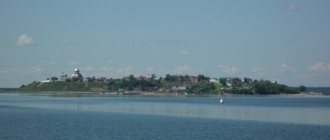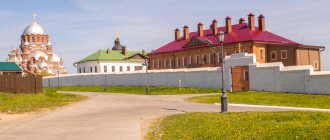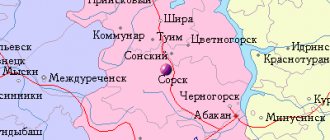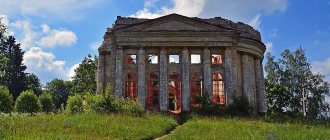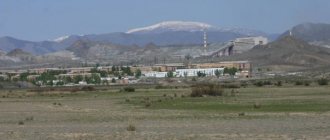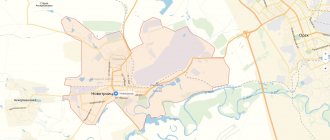| City Fatezh Coat of Arms |
| A country | Russia, Russia |
| Subject of the federation | Kursk regionKursk region |
| Municipal district | Fatezhsky |
| urban settlement | Fatezh city |
| Coordinates | 52°05′22″ n. w. 35°51′32″ E. d. / 52.08944° n. w. 35.85889° E. d. / 52.08944; 35.85889 (G) [www.openstreetmap.org/?mlat=52.08944&mlon=35.85889&zoom=12 (O)] (Z)Coordinates: 52°05′22″ N. w. 35°51′32″ E. d. / 52.08944° n. w. 35.85889° E. d. / 52.08944; 35.85889 (G) [www.openstreetmap.org/?mlat=52.08944&mlon=35.85889&zoom=12 (O)] (I) |
| First mention | 17th century |
| City with | 1779 |
| Square | OK. 4 km² |
| Center height | 200 |
| Population | ↗5994[1] people (2016) |
| Names of residents | fatezhans, fatezhanin, fatezhanka |
| Timezone | UTC+3 |
| Telephone code | +7 47144 |
| Postal codes | 307100 |
| Vehicle code | 46 |
| OKATO code | [classif.spb.ru/classificators/view/okt.php?st=A&kr=1&kod=38244501 38 244 501] |
| Fatezh Moscow |
| Kursk Fatezh |
Audio, photo and video
on Wikimedia Commons
Fatezh
- a city (since 1779[2]) in Russia, the administrative center of the Fatezhsky district of the Kursk region. Since 2006, the city of Fatezh has been forming an urban settlement.
Story
Founded in the 17th century. serving members of the same palace
(ethnic Cherkasy Cossacks[3]), on the banks of the Usozha River, like the village (or village)
Fatezh
. The name is presumably Circassian. At the same time, the stream flowing into the Usozha received the name “Fatezh”... At the end of the 17th century. The Fatezhans erected a defensive bastion on the banks of the then deep-flowing Usozh[4]. The first documentary mention of Fatezh is contained in the census sheets of 1719 (census of 1719). Shortly before (in 1702), by the will of the “Great Transformer” Peter I, the Cossacks-odnovortsy were illegally deprived of their noble title[5]…
By decree of Catherine II on the formation of the Kursk province of May 23, 1779, the village of Fatezh was transformed into the district town of Fatezh. On January 8, 1780, the coat of arms of the city of Fatezh, drawn up by King of Arms Volkov, was approved. In the upper part, as expected, the Kursk coat of arms was placed. And below is a shield divided in two: in one part there is a gun in a red field, and in the other there is a golden harrow in a green field. As the king of arms considered it his duty to emphasize, the inhabitants of Fatezh were ancient warriors who practiced arable farming in their free time
, in connection with which in the city coat of arms
a military weapon is combined with the tools of a careful tiller.
At the end of the 18th - beginning of the 19th centuries. in Fatezh they traded hemp, grain, honey, lard and wax. Until the end of the 19th century, the main occupations of the population remained agriculture and trade.
| Odnodvortsy worked, plowing up the hilly plain, awakening the black soil gilded with clay to fruitful power. (...) Fatezh fairs were famous throughout the district, held three times a year: on Pokrov, and on winter and summer Nikola. Geese, heifers and sheep were brought together, hemp, bristles, bread, honey, wax, and hare skins were sold. Merchants from Germany came to buy hemp hemp. |
- writes journalist Vladimir Erokhin (Literary Russia, July 20, 1979).
In 1856, there were 5 churches, 309 houses, and 112 shops in the city. In 1897, there were 2 Orthodox stone churches[6], a women's gymnasium, 2 primary schools, and a zemstvo hospital[7]. In 1907-08 Valentin Feliksovich Voino-Yasenetsky, later St. Luke of Crimea, worked as a zemstvo doctor in Fatezh... In the 20th century, production developed in Fatezh, including hemp spinning, and factories were built for processing local agricultural products. But the economic recovery was cut short by the Civil War... During the Great Patriotic War, Fatezh was occupied by Nazi troops from October 22, 1941 until February 7, 1943, when the headquarters of the commander of the Central Front, Colonel General K, was located in the Fatezh district (not far from the city). K. Rokossovsky. The following incident, terrible in its simplicity, was notable, which was once reported by journalist Vladimir Erokhin (“Literary Russia” dated July 20, 1979):
| There was nothing to pave the roads with. Rokossovsky ordered the demolished church in Fatezh to be dismantled and used for road construction. Troops and tanks passed over these stones[8]. |
Today in Fatezh there are:
- Church of the Icon of the Mother of God of Tikhvin (1800, 1845) - st. K Marx, 33.
- hotel "Fatezh" - st. Zagorodnyaya, 24.
- Fatezhskaya children's art school - st. Uritsky, 47.
In 1966, the village of Ulyanovka was annexed to the city, and in 1987, the village of 2nd Chaplygina[9].
In 2005, the administrative building on Uritsky Street, where the composer Sviridov was born, was reconstructed into his House-Museum.
Sights of the city of Fatezh (Kursk region)
The Kursk region is one of the largest in the Central Black Earth zone of the Russian Federation, located in the center of Russia in the forest-steppe zone on the slopes of the Central Russian Upland. Rivers and lakes, pastures and meadows, beautiful oak forests and protected steppes are the invaluable natural wealth of the Kursk region.
These places are home to over 300 species of vertebrates and several tens of thousands of invertebrate animals; There are 255 species of birds, including the famous Kursk nightingale, whose trills are considered the highest achievement of bird vocals.
Over the course of several centuries, the cultural potential and resources of the Kursk region have been formed. The region contains many monuments of architecture, archeology and art. In these places there are a large number of different cathedrals and monasteries - masterpieces of architecture from the era of Rastrelli.
Economy
- Hemp processing plant - built in 1926; currently not operational
- Knitwear production - not working
- Butter factory - practically not working
- Production of meat and bone meal - functioning
- Food processing plant - operational
- Brick factory - not functioning
Most of the city's industry fell into disrepair.
The only plus is that in the village of Chermoshnoy, which is near the city, an experimental baby food plant, a branch, is successfully developing, which provides work for a fairly large proportion of Fatezhans.
In the city itself, a significant share of jobs are provided by private entrepreneurs.
Maryino
In the Rylsky district of the Kursk region there is a very beautiful palace and park ensemble, the Maryino estate, the family estate of the Baryatinsky princes. The palace was the main residence of the princely family - it is a symbol of the dignity and greatness of the princely family.
The palace was built in the 19th century. (1811-1820) in a very beautiful corner of nature. Initially it was called the Izbitsky House because it was located on the banks of the Izbitsa River, but then they began to call it “Maryino” - the name of the owner’s wife, Countess Keller. During the construction of the house, a beautiful park was laid out, and the Maryinsky pond was built on the river. Later, in 1860, this beautiful place was complemented by a church built in the Byzantine style.
Until now, the center of the palace and park ensemble is a 3-story building with 1-story side wings, which form 2 large utility courtyards. Nowadays, this beautiful place has preserved marble stones, magnificent ceiling moldings, original parquet flooring and antique furniture. The picturesque park contains oval and round ponds with islands, which are connected by 3 bridges. On one island there is a Lutheran church, on the second there is a princely bath (16-column rotunda). On the outskirts of the estate, Mazepa's chamber has been preserved.
Famous people
Born in the city
- Baykov, Alexander Alexandrovich (1870-1946), chemist, metallurgist.
- Lyubich-Koshurov, Joasaf Arianovich (1872-1937), Russian children's writer.
- Pereverzev, Pavel Nikolaevich (1871-1944), lawyer, Minister of Justice of the Provisional Government.
- Sviridov, Georgy Vasilyevich (1915-1998), composer, People's Artist of the USSR.
- Firsov, Alexander Vasilievich (1922-1952), Hero of the Soviet Union.
They worked in the city
- surgeon Valentin Feliksovich Voino-Yasenetsky (in 1907-08)
Notes
- ↑ 12
www.gks.ru/free_doc/doc_2016/bul_dr/mun_obr2016.rar Population of the Russian Federation by municipalities as of January 1, 2021 - THE USSR. Administrative-territorial division of the union republics on January 1, 1980 / Compiled by V. A. Dudarev, N. A. Evseeva. - M.: Publishing house "Izvestia of the Soviets of People's Deputies of the USSR", 1980. - 702 p. — P. 157.
- The Cherkasy Cossacks were ancient immigrants from the Caucasus (hence their nickname), partly rooted in Ukraine (as well as on the Don, Middle and Lower Volga, in Kasimov and along the Belgorod line).
- The fortification work was supervised by the siege head Safron (Sofron) Gnezdilov.
- Peter I began his anti-domestic campaign with the liquidation of the Kasimov kingdom and the Kasimov Cossack army.
In 1818, a new church in honor of the Intercession of the Mother of God was founded in Fatezh on the corner of Northern (Karl Marx) and Tikhaya streets.
After 27 years, the widow of the merchant Elizaveta Kharichkova, in memory of her late husband and with his capital, erected the Tikhvin Church nearby, which became one architectural ensemble with the Pokrovsky Church. — [www.dddkursk.ru/number/775/planet/001448/ Anatoly BIRYUKOVSecrets of Fatezh dungeons]
- Encyclopedic Dictionary of Brockhaus and Efron.
- We are talking here, obviously, about the aforementioned Church of the Intercession, built in 1818.
- [archive.rkursk.ru/gako/fond_guide Guide to the funds of the state archive of the Kursk region]
- ↑ 1234567891011121314151617
[www.MojGorod.ru/kursk_obl/fatezh/index.html People's encyclopedia “My City”. Fatezh]. Retrieved January 25, 2014. [www.webcitation.org/6MtKcjW3F Archived from the original on January 25, 2014]. - [demoscope.ru/weekly/ssp/rus59_reg2.php All-Union Population Census of 1959. The size of the urban population of the RSFSR, its territorial units, urban settlements and urban areas by gender] (Russian). Demoscope Weekly. Retrieved September 25, 2013. [www.webcitation.org/6GDOghWC9 Archived from the original on April 28, 2013].
- [demoscope.ru/weekly/ssp/rus70_reg2.php All-Union Population Census of 1970 The size of the urban population of the RSFSR, its territorial units, urban settlements and urban areas by gender.] (Russian). Demoscope Weekly. Retrieved September 25, 2013. [www.webcitation.org/6GDOiMstp Archived from the original on April 28, 2013].
- [demoscope.ru/weekly/ssp/rus79_reg2.php All-Union Population Census of 1979 The size of the urban population of the RSFSR, its territorial units, urban settlements and urban areas by gender.] (Russian). Demoscope Weekly. Retrieved September 25, 2013. [www.webcitation.org/6GDOjhZ5L Archived from the original on April 28, 2013].
- [demoscope.ru/weekly/ssp/rus89_reg2.php All-Union Population Census of 1989. Urban population]. [www.webcitation.org/617x0o0Pa Archived from the original on August 22, 2011].
- [www.perepis2002.ru/ct/doc/1_TOM_01_04.xls All-Russian Population Census 2002. Volume. 1, table 4. Population of Russia, federal districts, constituent entities of the Russian Federation, districts, urban settlements, rural settlements - regional centers and rural settlements with a population of 3 thousand or more]. [www.webcitation.org/65AdCU0q3 Archived from the original on February 3, 2012].
- [www.gks.ru/bgd/regl/B09_109/IssWWW.exe/Stg/d01/tabl-21-09.xls Number of permanent population of the Russian Federation by cities, urban-type settlements and districts as of January 1, 2009]. Retrieved January 2, 2014. [www.webcitation.org/6MJmu0z1u Archived from the original on January 2, 2014].
- [kurskstat.gks.ru/wps/wcm/connect/rosstat_ts/kurskstat/resources/ee617b804e86dcf6bf81ffb8fc91c3ba/vol+1.pdf All-Russian Population Census 2010. Volume 1. Number and distribution of the population of the Kursk region]. Retrieved January 31, 2014. [www.webcitation.org/6N2ZGXrqv Archived from the original on January 31, 2014].
- [www.gks.ru/free_doc/doc_2012/bul_dr/mun_obr2012.rar Population of the Russian Federation by municipalities. Table 35. Estimated resident population as of January 1, 2012]. Retrieved May 31, 2014. [www.webcitation.org/6PyOWbdMc Archived from the original on May 31, 2014].
- [www.gks.ru/free_doc/doc_2013/bul_dr/mun_obr2013.rar Population of the Russian Federation by municipalities as of January 1, 2013. - M.: Federal State Statistics Service Rosstat, 2013. - 528 p. (Table 33. Population of urban districts, municipal districts, urban and rural settlements, urban settlements, rural settlements)]. Retrieved November 16, 2013. [www.webcitation.org/6LAdCWSxH Archived from the original on November 16, 2013].
- [www.gks.ru/free_doc/doc_2014/bul_dr/mun_obr2014.rar Table 33. Population of the Russian Federation by municipalities as of January 1, 2014]. Retrieved August 2, 2014. [www.webcitation.org/6RWqP50QK Archived from the original on August 2, 2014].
- [www.gks.ru/free_doc/doc_2015/bul_dr/mun_obr2015.rar Population of the Russian Federation by municipalities as of January 1, 2015]. Retrieved August 6, 2015. [www.webcitation.org/6aaNzOlFO Archived from the original on August 6, 2015].
- taking into account the cities of Crimea
- [www.gks.ru/free_doc/doc_2016/bul_dr/mun_obr2016.rar Population of the Russian Federation by municipalities as of January 1, 2021. Table “31. Population of cities and towns by federal districts and constituent entities of the Russian Federation as of January 1, 2021.” RAR archive (1.0 MB)]
Indigenous deserts
Root Nativity of the Mother of God Hermitage is one of the first monasteries in the Kursk region. It is located in a very beautiful and picturesque place on the right bank of the Tuskar River. In the greenery of the vast forest one can see the golden crosses of the monastery monasteries, white stone steps descending to the river and the Church of the Life-Giving Spring, founded in 1957 on the site of the miraculous appearance of the Kursk Root Icon of the Mother of God “The Sign”. The steps fit perfectly into the beautiful ensemble of the monastery and create maximum convenience for pilgrims and pilgrims. From all the platforms and steps the middle of the church is visible, and the divine service being performed in it can be clearly heard.
The construction of the Root Desert was very difficult. Only towards the end of the 18th century. it was completely completed. On both sides of the Holy Gate there were two-story brethren's and abbot's cells. On the left side of the desert the All Saints Monastery was founded, and behind the monastery there were 2 living rooms. On the territory of the sacred place there was a beautiful monastery garden.
At the moment, there are 4 churches in the monastery, but mainly services are conducted only in one of them - the Nativity of the Blessed Virgin Mary.
Excerpt characterizing Fatezh
- I'll give you a light one. Little shooter! – Mavra Kuzminishna shouted, raising her hand at him. - Go and set up a samovar for grandfather. Mavra Kuzminishna, brushing off the dust, closed the clavichord and, sighing heavily, left the living room and locked the front door. Coming out into the courtyard, Mavra Kuzminishna thought about where she should go now: should she drink tea in Vasilich’s outbuilding or tidy up what had not yet been tidied up in the pantry? Quick steps were heard in the quiet street. The steps stopped at the gate; the latch began to knock under the hand that was trying to unlock it. Mavra Kuzminishna approached the gate. - Who do you need? - Count, Count Ilya Andreich Rostov. - Who are you? - I'm an officer. “I would like to see,” said the Russian pleasant and lordly voice. Mavra Kuzminishna unlocked the gate. And a round-faced officer, about eighteen years old, with a face similar to the Rostovs, entered the courtyard. - We left, father. “We deigned to leave at vespers yesterday,” Mavra Kuzmipishna said affectionately. The young officer, standing at the gate, as if hesitant to enter or not to enter, clicked his tongue. “Oh, what a shame!..” he said. - Yesterday I wish... Oh, how sorry!.. Mavra Kuzminishna, meanwhile, carefully and sympathetically examined the familiar features of the Rostov breed in the face of the young man, and the tattered overcoat, and the worn-out boots that he was wearing. - Why did you need a count? – she asked. - Yeah... what to do! - the officer said with annoyance and grabbed the gate, as if intending to leave. He stopped again, undecided. – Do you see? - he suddenly said. “I am a relative of the count, and he has always been very kind to me.” So, you see (he looked at his cloak and boots with a kind and cheerful smile), and he was worn out, and there was no money; so I wanted to ask the count... Mavra Kuzminishna did not let him finish. - You should wait a minute, father. Just a minute,” she said. And as soon as the officer released his hand from the gate, Mavra Kuzminishna turned and with a quick old woman’s step walked into the backyard to her outbuilding. While Mavra Kuzminishna was running to her place, the officer, with his head down and looking at his torn boots, smiling slightly, walked around the yard. “What a pity that I didn’t find my uncle. What a nice old lady! Where did she run? And how can I find out which streets are the closest to catch up with the regiment, which should now approach Rogozhskaya? - the young officer thought at this time. Mavra Kuzminishna, with a frightened and at the same time determined face, carrying a folded checkered handkerchief in her hands, came out from around the corner. Without walking a few steps, she unfolded the handkerchief, took out a white twenty-five-ruble note from it and hastily gave it to the officer. “If their Lordships were at home, it would be known, they would definitely be related, but maybe... now...” Mavra Kuzminishna became shy and confused. But the officer, without refusing and without haste, took the piece of paper and thanked Mavra Kuzminishna. “As if the count were at home,” Mavra Kuzminishna kept saying apologetically. - Christ is with you, father! God bless you,” said Mavra Kuzminishna, bowing and seeing him off. The officer, as if laughing at himself, smiling and shaking his head, ran almost at a trot through the empty streets to catch up with his regiment to the Yauzsky Bridge. And Mavra Kuzminishna stood for a long time with wet eyes in front of the closed gate, thoughtfully shaking her head and feeling an unexpected surge of maternal tenderness and pity for the officer unknown to her. In the unfinished house on Varvarka, below which there was a drinking house, drunken screams and songs were heard. About ten factory workers were sitting on benches near tables in a small dirty room. All of them, drunk, sweaty, with dull eyes, straining and opening their mouths wide, sang some kind of song. They sang separately, with difficulty, with effort, obviously not because they wanted to sing, but only to prove that they were drunk and partying. One of them, a tall, blond fellow in a clear blue scent, stood above them. His face with a thin, straight nose would be beautiful if it were not for his thin, pursed, constantly moving lips and dull, frowning, motionless eyes. He stood over those who were singing, and, apparently imagining something, solemnly and angularly waved his white hand rolled up to the elbow over their heads, the dirty fingers of which he unnaturally tried to spread out. The sleeve of his tunic was constantly falling down, and the fellow diligently rolled it up again with his left hand, as if there was something particularly important in the fact that this white, sinewy, waving arm was certainly bare. In the middle of the song, screams of fighting and blows were heard in the hallway and on the porch. The tall fellow waved his hand. - Sabbath! – he shouted imperiously. - Fight, guys! - And he, without ceasing to roll up his sleeve, went out onto the porch. The factory workers followed him. The factory workers, who were drinking in the tavern that morning under the leadership of a tall fellow, brought skins from the factory to the kisser, and for this they were given wine. The blacksmiths from the neighboring cousins, hearing the noise in the tavern and believing that the tavern was broken, wanted to force their way into it. A fight broke out on the porch. The kisser was fighting with the blacksmith at the door, and while the factory workers were coming out, the blacksmith broke away from the kisser and fell face down on the pavement. Another blacksmith was rushing through the door, leaning on the kisser with his chest. The guy with his sleeve rolled up hit the blacksmith in the face as he was rushing through the door and shouted wildly: “Guys!” They're beating our people! At this time, the first blacksmith rose from the ground and, scratching the blood on his broken face, shouted in a crying voice: “Guard!” Killed!.. Killed a man! Brothers!.. - Oh, fathers, they killed him to death, they killed a man! - the woman squealed as she came out of the neighboring gate. A crowd of people gathered around the bloody blacksmith. “It’s not enough that you robbed people, took off their shirts,” said someone’s voice, turning to the kisser, “why did you kill a person?” Robber! The tall fellow, standing on the porch, looked with dull eyes first at the kisser, then at the blacksmiths, as if wondering who he should fight with now. - Murderer! – he suddenly shouted at the kisser. - Knit it, guys! - Why, I tied up one such and such! - the kisser shouted, waving off the people who attacked him, and, tearing off his hat, he threw it on the ground. As if this action had some mysteriously threatening significance, the factory workers who surrounded the kisser stopped in indecision. “Brother, I know the order very well.” I'll get to the private part. Do you think I won't make it? Nowadays no one is ordered to commit robbery! – the kisser shouted, raising his hat. - And let's go, look! And let's go... look! - the kisser and the tall fellow repeated one after another, and both moved forward along the street together. The bloody blacksmith walked next to them. Factory workers and strangers followed them, talking and shouting. At the corner of Maroseyka, opposite a large house with locked shutters, on which was a sign of a shoemaker, stood with sad faces about twenty shoemakers, thin, exhausted people in dressing gowns and tattered tunics. - He will treat the people properly! - said a thin craftsman with a scraggly beard and frowning eyebrows. - Well, he sucked our blood - and that’s it. He drove us, drove us - all week. And now he brought it to the last end, and left. Seeing the people and the bloody man, the worker who had been speaking fell silent, and all the shoemakers, with hasty curiosity, joined the moving crowd. -Where are the people going? - It is known where, he goes to the authorities. - Well, did our power really not take over? - And you thought how! Look what the people are saying. Questions and answers were heard. The kisser, taking advantage of the increase in the crowd, fell behind the people and returned to his tavern. The tall fellow, not noticing the disappearance of his enemy the kisser, waving his bare arm, did not stop talking, thereby drawing everyone’s attention to himself. The people mostly pressed on him, expecting from him to get a solution to all the questions that occupied them. - Show him order, show him the law, that’s what the authorities are in charge of! Is that what I say, Orthodox? - said the tall fellow, smiling slightly. – He thinks, and there are no authorities? Is it possible without bosses? Otherwise, you never know how to rob them. - What nonsense to say! - responded in the crowd. - Well, then they’ll abandon Moscow! They told you to laugh, but you believed it. You never know how many of our troops are coming. So they let him in! That's what the authorities do. “Listen to what the people are saying,” they said, pointing to the tall fellow.
